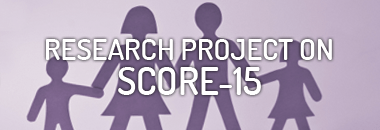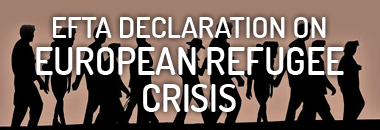EUROPEAN FAMILY THERAPY ASSOCIATION
CONNECTING FAMILY THERAPISTS AND TRAINERS
Why Family Therapy?
Arguments in favour of “Family and Couple Therapy / Systemic Therapy”
Research and text: Michelle Bischoff and Severine Bessero
Coordination: Benedict Reverdin, Nicola Gervasoni and Philip Nielsen
Expertise and scientific supervision: Prof. Nicolas Favez (University of Geneva)
Working Group: Benoit Reverdin, Philip Nielsen, Nicola Gervasoni, Michelle Bischoff and Severine Bessero (AGTF); Nicolas Favez (University of Geneva); Raymond Traube (SISTEMICA), Daniel Krähenbühl (SGS), Heidi Oetiker (VEF); Valérie Le Goff and Robert Neuburger (ASTHEFIS).
This set of arguments is the result of collaboration between the national and cantonal associations for family and systemic therapy and marriage counselling (SISTEMICA, ASTHEFIS, SGS, Stirpe, VEF).
- ASTHEFIS: Swiss Association for Family Therapy and Systemic Intervention
- SGS: Swiss Society for Systemic Therapy and Counselling
- SISTEMICA: Swiss Federation of Family Therapy Associations
- VEF: Association for Marriage and Family Counselling/Therapy
- STIRPS: Società Ticinese di Ricerca e Psicoterapia Sistemica
- AGTF: Geneva Family Therapy Association
Foreword
Therapeutic approaches to the family and the couple are enjoying a significant revival of interest in Switzerland and elsewhere in Europe. This renewed momentum comes at a crucial time in the history of psychotherapy: on the one hand, we are witnessing an accumulation of knowledge about their efficacy thanks to the growing body of scientific research in a clinical environment; on the other hand, a debate is under way in various countries – including Switzerland – on the criteria for reimbursement of psychotherapy by the health insurance funds. This debate will have a decisive impact on how the psychotherapeutic landscape is shaped in the future.
The purpose of this set of arguments – which is the result of collaboration between the national associations for family/couple and systemic therapy – is to review the complex issue of the efficacy of these therapies, based on the scientific literature. It has been written according to the following principles:
- the selected references are from research carried out in keeping with the most rigorous scientific standards, as defined in the field of empirically-validated treatments (Nathan & Gorman, 2007);
- the area of application described is that of the psychological disorders recognized by the Swiss Health Insurance Act (LaMal). Thus some research work proving the efficacy of family and couples psychotherapy in areas not recognized by the Health Insurance Act has not been mentioned;
- the description of the search for efficacy is divided into two main parts: one devoted to voluntary approaches on the part of the patient, the other to non- voluntary approaches. This is because it seemed particularly relevant to stress the efficacy of family therapy in areas in which the patient refuses treatment or does not seek it and which constitute problems having a considerable social impact. A third part presents the data on the economic viability of these therapies;
- Finally, the set of arguments is not intended to serve as a directory of the different practices, but focuses on the factors common to the various family approaches.
Introduction
Therapeutic approaches to the family and the couple: What do they involve?
In this paper we adopt the following definitions to describe the therapeutic approaches to the family and the couple:
“Any form of isolated or repeated psychotherapy or intervention comprising at least two people forming part of the life or survival context of one or more persons in distress – that is, sharing a common destiny”. (Collectif INSERM, 2004).
“Family therapy is concerned with the problems and suffering that a person presents within the relational context made up of other persons of significant importance and of his/her social network”. (NFTO, National Family Therapy Organisations, 2009).
In the context of this definition we will look at family and couple psychotherapy, as well as other family interventions including psychoeducation and multi-family groups. Psychoeducation offers families the adaptive attitudes to be taken when faced with disturbances related to the illness of a member of the family. Multi-family groups comprise, for therapeutic purposes, several families often exhibiting a common problem. In general, exchange of information, mutual assistance, how to cope with the problems encountered and the development of inter-family solidarity are encouraged in such groups.
The first family therapies emerged in the late 1930s in the USA. At that time psychotherapy was carried out mainly in individual consultations. Family therapy developed from a dual clinical observation: firstly, practitioners had noticed the deterioration of the condition of patients in hospital following a visit from their family; secondly, inclusion of the family in the treatment resulted, on the contrary, in an improvement in the symptoms. Since that time, family therapy has constantly evolved, giving rise to various schools of thought. It was during the 1970s that it developed in Europe.
We find family therapy in a number of areas of intervention, both medical and psychological or social. It is taught and practised in most psychiatric institutions in Switzerland.
The basic principles of family therapy
The family therapy schools rely on various theoretical inputs, but they share the following assumptions:
- the problematic behaviour patterns and experiences of individuals are linked to family interactions and relationships and the context in which they develop;
- a change in interpersonal relationships causes a change in the patient, or reinforces a change that is taking place;
- therapeutic work focuses on family interactions in the here and now;
- the resources and autonomy of patients and their families are used as therapeutic levers.
Family therapy can be performed according to several psychotherapeutic models (systemic, cognitive-behavioural and psychodynamic). However, most of them are predicated on the systemic model. In the remainder of this text we will generally use the acronyms FT/ST (family therapy/systemic therapy) to discuss family and couples psychotherapy.
To which situations does FT/ST apply?
Originally, FT/ST emerged as a mode of therapeutic response to serious psychiatric problems such as schizophrenia. It gradually expanded to cover a wide range of disorders, including psychotic disorders in the broad sense, psychosomatic disorders, eating behaviour disorders, addictions, dementia, child abuse, spousal and family violence. It generally involves relatively short courses of therapy: between 6 and 20 sessions.
Research review
Types of psychotherapy research
To date, efficacy data on psychotherapy derive mainly from two types of studies recognized for their scientific validity: so-called efficacy studies1 and effectiveness studies2. For this paper we have taken these two types of studies, along with cost effectiveness studies3. By way of simplification, we will generally use the term effectiveness to report the results of both efficacy and effectiveness studies.
- 1. Efficacy studies are conducted under controlled conditions, characterized by the formation of a group of patients suffering from similar disorders and subject to a standardized and manualized therapeutic process, which is compared to a control group receiving no treatment or an alternative treatment.
- 2. Effectiveness studies address the effects of a psychotherapeutic intervention as provided in routine clinical practice.
- 3. “Cost-effectiveness” studies compare the costs of an intervention or programme, to which a monetary value is attributed, with the effects of the intervention or programme in question being expressed by other measures.
Effectiveness of FT/ST
The effectiveness of FT/ST is today well established in general and for many specific clinical problems.
FT/ST is effective either as a single treatment or combined with another form of treatment, such as a pharmacological treatment or an individual, social or educational treatment. The results of the most recent research that we are presenting below have been recapitulated and summarized in several books and high-level scientific papers that the reader will find mentioned in the bibliography; one of these references is in French (Elkaïm, 2007), one in German (von Sydow, Beher, Metzlaff & Schweitzer, 2007); all the others are available in English only (Carr, 2009a, 2009b; Fonagy, Target, Cottrell, Phillips & Kurtz, 2002, Roth & Fonagy, 2005; Nathan & Gorman, 2007; Sexton, Alexander & Mease, 2004; Shadish & Baldwin, 2003; Stratton, 2005).
Effectiveness of FT/ST for problems in which patients are generally not directly seeking care
FT/ST often proves more effective than individual therapy for serious problems in which patients are not – or are not actively – seeking care, such as anti-social behaviour, substance abuse, eating disorders or psychotic disorders. These situations are characterized by difficulty in persuading the patient to accept treatment and keeping him/her under treatment. Refusals to accept treatment or interruptions in the latter have serious consequences for the patient’s family circle and generate a high social cost, particularly in terms of hospitalizations. The involvement of the family/partner in the treatment process for this type of disorder proves very effective.
Summary of key research results in patients generally not seeking treatment
- Behavioural disorders/juvenile delinquency problems. FT/ST allows for a significant improvement in behavioural disorders among children and adolescents, and does so more markedly than during individual treatment.
- Attention-deficit and hyperactivity disorder (ADHD) in children. FT/ST allows for a significant improvement in attention and hyperactivity disorders in children. When combined with pharmacological treatment, FT/ST is considered the treatment of choice.
- Addictive behaviours and alcohol-related problems. FT/ST allows for a greater reduction of substance consumption and better compliance with therapeutic programmes than individual treatments.
- Eating behaviour disorders. FT/ST allows for a significant improvement in cases of mental anorexia and a greater reduction of relapses than in individual therapy situations. Similarly, FT/ST proves as effective as or more effective than individual psychotherapy in cases of bulimia during adolescence.
- Schizophrenia and other psychotic disorders. The main results show that FT/ST, when combined with pharmacological treatment and individual therapeutic monitoring, reduces the number of relapses and increases patient compliance with pharmacological treatment. In addition, FT/ST allows for an improvement in relations between the patient and his/her family by reducing the stress that they perceive in the management of the patient’s disorder.
Effectiveness of FT/ST for problems in which patients are generally seeking treatment
FT/ST proves effective in many “conventional” situations in which treatment is sought, either as a sole treatment or in combination with other treatments.
Summary of key research results in patients seeking treatment
- Mood disorders. FT/ ST is as effective as individual treatments in cases of depression. It allows for better compliance with treatment than pharmacological treatment. FT/ST conducted with an adolescent after a suicide attempt reduces depression and the risk of recurrent suicide attempts. In addition, it allows for better compliance with specialized treatment. Regarding bipolar disorders, FT/ST, combined with a pharmacological treatment, is the most effective approach.
- Anxiety Disorders. FT/ST, combined with a pharmacological treatment, is the most effective approach for the treatment of obsessive compulsive disorders and agoraphobia. FT/ST is more effective than individual therapies for children/adolescents suffering from anxiety disorders, and for their families in difficulty.
- Psychosomatic disorders in children and adults. FT/ST is effective in treating chronic pains, and for enuresis, encopresis, diabetes, chronic abdominal pains and asthma.
- Psycho-sexual disorders. Psycho-sexual disorders are, in most cases, accompanied by marital distress, which reinforces the indication of treatment as a couple. The main results indicate that FT/ST is effective for desire disorders in men and women, anorgasmia, vaginismus and dyspareunia. In addition, erectile dysfunction and premature ejaculation are treated most effectively as part of FT/ST combined with pharmacological treatment.
- Marital distress. FT/ST is recognized as being effective in reducing marital distress, particularly during therapy comprising an average of about twenty sessions.
“Cost-effectiveness studies”
All of these studies highlight the economic viability of FT/ST, both for the patient and for the members of his/her family circle. It offers good value for money and is often less expensive than other types of treatment by giving rise, in particular, to a reduction in the use of treatment services. (Crane, 2008).
FT/ST allows for cost savings greater than other treatment programmes in situations of juvenile delinquency. Similarly, among young cannabis users, family therapy proves less expensive than outpatient treatment in a day-care centre. In cases of depression, FT/ST has a cost equivalent to that of drug-based therapy. In persons suffering from psychotic disorders, FT/ST reduces the number of hospitalizations. Finally, FT/ST leads to a reduction in costs by contributing significantly to reducing treatment duplication within the same family (Von Sydow, Beher, Retzlaff & Schweitzer, 2007).
Conclusion
The findings from psychotherapy research indisputably show that for many mental disorders, FT/ST are highly recommended for both their effectiveness and for the sustainability of their effect.
Among the major advantages: FT/ST helps to alleviate the suffering of family members faced with a psychological problem affecting one of their members. Thus the therapy can prevent the latter from in turn requiring individual therapeutic treatment, which represents a substantial saving for the health care system. The cost-effectiveness studies highlight the financial viability of this type of treatment.
Given these results, we support the development of the family-based approaches at the level of both practice and of teaching and research. FT/ST is a high-quality intervention that often complements other treatments of psychological problems.
In summary
FT/ST is effective.
FT/ST is particularly effective during severe and complex disorders requiring extensive treatment and where the patient is generally not seeking treatment:
- Anti-social conduct and delinquency
- Eating behaviour disorders
- Substance abuse
- Depression/Suicidal tendencies
- Psychotic disorders
- Psychosomatic disorders
In the case of severe organic and/or mental disorders, FT/ST is optimal when combined with other therapeutic approaches.
Bibliography
Books and papers recapitulating the principal results of research on the effectiveness of FT/ST:
- Carr, A. (2009a). The effectiveness of family therapy and systemic interventions for child-focused problems. Journal of Family Therapy, 31, 3-45.
- Carr, A. (2009b). The effectiveness of family therapy and systemic interventions for adult-focused problems. Journal of Family Therapy, 31, 46-74.
- Crane, R. (2008). The cost-effectiveness of family therapy: a summary and progress report. Journal of Family Therapy, 30, 399-410.
- Elkaïm, M. (2007). Comprendre et traiter la souffrance psychique. Paris: Seuil.
- Fonagy, P., Target, M., Cottrell, D., Phillips, J., Kurtz, Z. (2002). What Works for Whom: A Critical Review of Treatments for Children and Adolescents. New York: Guilford.
- Collectif INSERM (2004). Psychothérapie: Trois approches évaluées. Paris: Les éditions INSERM.
- Nathan, P. & Gorman, J. (2007). A guide to treatments that work (3rd ed.). New York: Oxford Press.
- NFTO (National Family Therapy Organizations), core text, 2009.
- Roth, A. & Fonagy, P. (2005). What works for whom? A critical review of psychotherapy research (2nd edition). New York: Guilford.
- Sexton, T.L., Alexander, J. F., Mease, A.L. (2003). Levels of evidence for the models and mechanisms of therapeutic change in family and couple therapy. In A. E. Bergin & S. L. Garfield (Eds.), Handbook of Psychotherapy and Behavior Change. New York: John Wiley & Sons, pp.590-646.
- Shadish, W.R., & Baldwin, S.A. (2003). Meta-analysis of MFT interventions. Journal of Marital and Family Therapy, 29.
- Stratton, P. (2005). Report on the evidence of systemic family therapy. Warrington: Association for Family Therapy.
- Von Sydow, K., Beher, S., Retzlaff, R., & Schweitzer, J. (2007). Die Wirksamkeit der Systemischen Therapie / Familientherapie. Hogrefe-Verlag.
A more detailed bibliography can be obtained from the authors.
Descargar Argumentación (Español)



